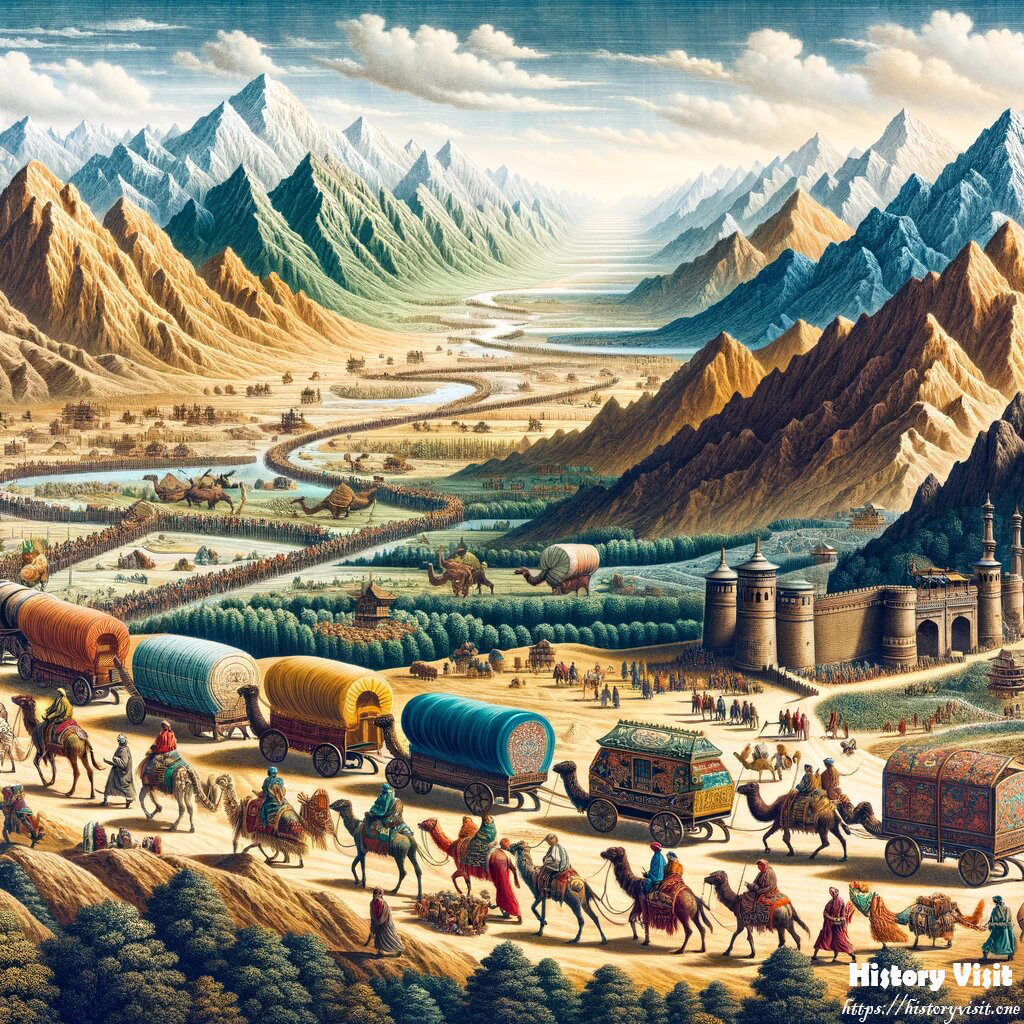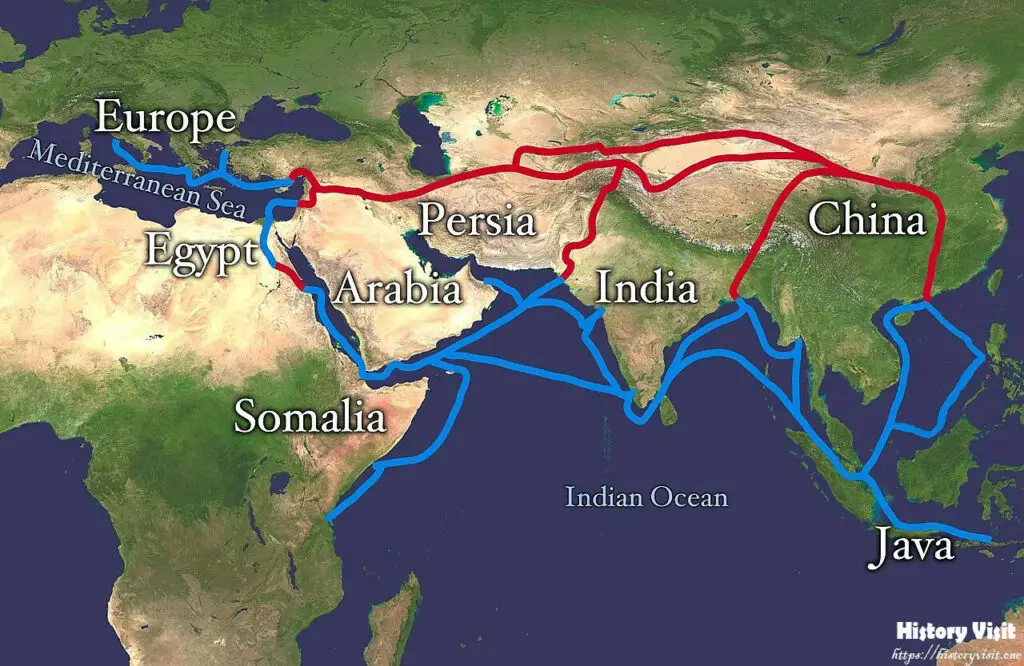The Silk Road Secrets: How It Revolutionized the World!

Introduction of The Silk Road
The Silk Road, a network of ancient trade routes, stands as one of history’s most significant pathways of cultural, economic, and political exchange. Stretching over 7,000 miles, this vast web connected the East and West, linking China with the Mediterranean, and facilitating an unparalleled flow of goods, ideas, and people. Beyond mere trade, the Silk Road acted as a bridge between civilizations, fostering an exchange that shaped the course of history.
While the Silk Road is often associated with the trade of luxurious silk, its significance extends far beyond. This route enabled the movement of spices, precious metals, textiles, and other commodities, establishing a foundation for global commerce. Moreover, it served as a conduit for cultural and intellectual exchange, spreading religions, philosophies, and technologies across continents.
In this article, we will delve into the origins and development of the Silk Road, examine its role in trade and commerce, explore its cultural impacts, and discuss its decline and enduring legacy. Through this journey, we aim to uncover how the Silk Road not only connected the East and West but also transformed them in the process.
Origins and Development of The Silk Road
The origins of the Silk Road can be traced back to the Han Dynasty in China around the 2nd century BCE. Emperor Wu of Han initiated its creation to foster trade relationships with the West and secure alliances against northern nomadic tribes. This ambitious project saw the establishment of trade routes that would stretch from China, through Central Asia, and into the heart of the Roman Empire.
Geographically, the Silk Road was not a single route but a network of interconnecting pathways. The northern route passed through the arid steppes of Central Asia, while the southern route navigated the rugged terrains of the Iranian Plateau. These routes converged at various points, such as the city of Kashgar, forming a complex web of trade paths that facilitated the flow of goods and culture.
Key figures and empires played crucial roles in the development of the Silk Road. Notable among them were the Persian Empire, which provided safe passage through its territories, and the Byzantine Empire, which became a major terminus for goods heading to Europe. These empires, along with various Central Asian kingdoms, ensured the protection and prosperity of the Silk Road, making it a thriving conduit for commerce and cultural exchange.
Trade and Commerce

The Silk Road was synonymous with the trade of silk, which was highly coveted in the West for its rarity and luxurious quality. However, silk was just one of many commodities traded along this route. Spices, such as cinnamon and pepper, flowed from India and Southeast Asia, while precious stones and metals, like jade and silver, traveled from Central Asia. This extensive trade network allowed for the exchange of diverse goods, enriching the cultures and economies of the regions it connected.
Innovations in trade and transportation played a pivotal role in the success of the Silk Road. The introduction of caravanserais—inns where travelers could rest and resupply—made long-distance trade more feasible. Advances in shipbuilding and navigation also allowed maritime routes to complement the overland pathways, enhancing the efficiency and reach of the Silk Road.
The economic impact of the Silk Road was profound, not only on local economies but also on a global scale. Cities along the route, such as Samarkand, Bukhara, and Chang’an, flourished as bustling trade hubs. These cities became melting pots of cultures, attracting merchants, scholars, and artisans from all over the world. The wealth generated from trade spurred economic development, leading to advancements in infrastructure, art, and science.
Cultural Exchange of The Silk Road

The Silk Road was a significant conduit for cultural exchange, facilitating the spread of religions, philosophies, and artistic styles across vast distances. Buddhism, for instance, traveled from India to China along the Silk Road, profoundly influencing Chinese culture and leading to the establishment of numerous temples and monasteries. Similarly, Islam spread through Central Asia and into China, leaving a lasting impact on the region’s architecture, art, and traditions.
The exchange of ideas and knowledge was equally transformative. Scientific advancements, such as Chinese papermaking and printing, reached the Islamic world and Europe via the Silk Road, revolutionizing communication and education. Medical knowledge, astronomical theories, and technological innovations were shared and adapted, fostering a rich tapestry of intellectual growth across cultures.
Art and literature also flourished as a result of this intercultural interaction. The blending of Greek, Persian, Indian, and Chinese artistic traditions led to unique and enduring styles seen in sculpture, painting, and literature. The diffusion of stories and fables, like the Indian Panchatantra and Persian Shahnameh, enriched the literary traditions of various cultures along the Silk Road, leaving an indelible mark on global heritage.
Decline and Legacy
Several factors contributed to the decline of the Silk Road, including political instability, economic shifts, and the rise of maritime trade routes. The fall of the Mongol Empire, which had previously ensured the safety and stability of the Silk Road, led to increased banditry and insecurity. Additionally, the discovery of sea routes to Asia by European explorers in the 15th century provided a faster and safer alternative to overland travel, further diminishing the importance of the Silk Road.
Despite its decline, the legacy of the Silk Road endures in many ways. Modern trade routes and global supply chains can trace their origins to the networks established by the Silk Road. The cultural and technological exchanges that occurred along these ancient paths laid the groundwork for the interconnected world we live in today. Furthermore, several cities and landmarks along the Silk Road have been designated UNESCO World Heritage Sites, preserving their historical and cultural significance for future generations.
The Silk Road’s enduring impact is also evident in contemporary cultural exchanges. The rich heritage of multiculturalism fostered by the Silk Road continues to influence art, music, cuisine, and philosophy. This ancient highway of connectivity serves as a reminder of the profound benefits of cultural interaction and exchange in building a more integrated and understanding world.
Conclusion of The Silk Road
In conclusion, the Silk Road was much more than a trade route; it was a vital link that connected diverse civilizations, fostering economic prosperity and cultural enrichment. From its origins in the Han Dynasty to its decline in the face of emerging maritime trade routes, the Silk Road played a pivotal role in shaping the course of history.
The trade and commerce facilitated by the Silk Road led to the exchange of valuable goods and innovations, enriching the economies of the regions it connected. More importantly, the cultural interactions along the Silk Road fostered the spread of religions, ideas, and artistic traditions, leaving a lasting legacy that continues to influence our world today.
As we reflect on the significance of the Silk Road, it serves as a powerful reminder of the importance of connectivity and exchange. In an increasingly globalized world, the lessons of the Silk Road remind us that the flow of goods, ideas, and cultures can lead to greater understanding and prosperity for all. The ancient highway that once connected East and West continues to inspire and inform the interconnected paths of our modern world.


